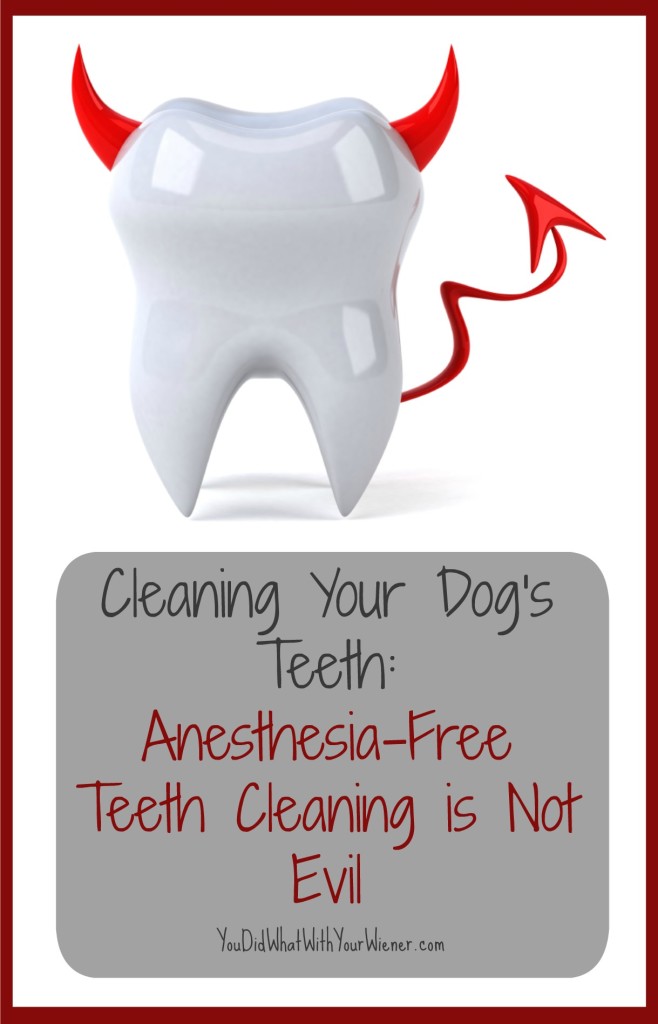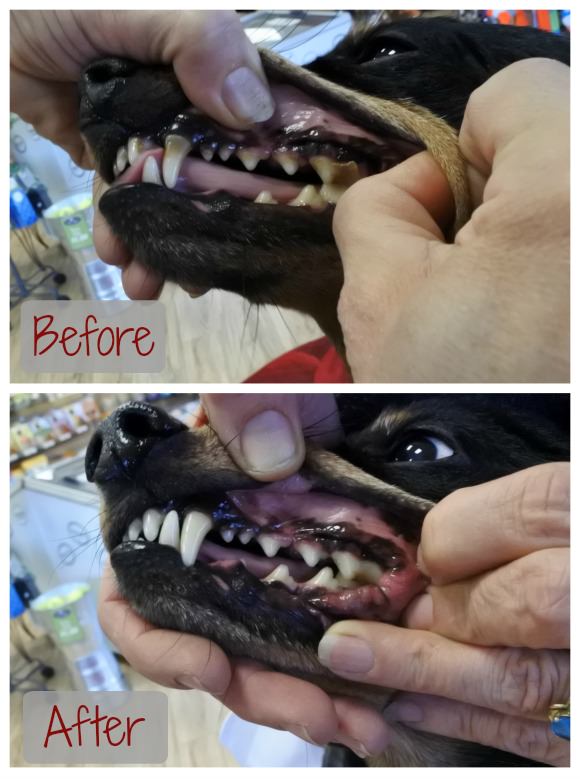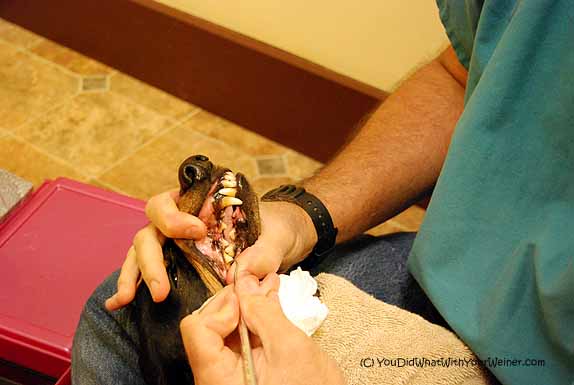How To Clean Your Dog's Teeth Without Anesthesia
 I previously wrote an article about the anesthesia-free teeth cleaning that Chester gets. My vet says that his teeth look great for his age and there are no signs that he should have a full dental cleaning under anesthesia. Due to his age (13) I prefer to not put him under anesthesia unless my vet deems it medically necessary.
I previously wrote an article about the anesthesia-free teeth cleaning that Chester gets. My vet says that his teeth look great for his age and there are no signs that he should have a full dental cleaning under anesthesia. Due to his age (13) I prefer to not put him under anesthesia unless my vet deems it medically necessary.
I don't brush his teeth though. I've written about this before too. I've had a lot of people try to "convince" me that brushing the gold standard and THE best thing to do for preventative care. I don't need convincing though. I know it's true. I also know that it's not going to happen.
I go WAY above and beyond for their health in other areas but brushing is something I don't want to fight with them over. I'm not good with routine either. I can barely remember to brush my own teeth 🙂 That doesn't mean I totally neglect their teeth though. Because I don't brush their teeth, I do this instead. I also get anesthesia-free teeth cleaning for them to help keep the bacteria and tartar at bay.
Since writing about anesthesia-free teeth cleaning, I've been berated and stalked (yes, stalked…. I can see your email address and see you work for a vet) repeatedly with comments about how anesthesia-free teeth cleaning is horrible and Chester will die if he gets it. I disagree. Here's why.
Anesthesia-free Teeth Cleaning – The Negative Claims
I am pretty sure I've heard every argument in the book about Professional Outpatient Preventive Dentistry (POPD) – the technical term for anesthesia-free canine dental cleaning. If I haven't, I am sure I will after people read this article. Despite the very vocal detractors, I feel strongly that I have made the right choice for Chester.
I admit I am not a vet and that these are all personal opinions based on very thorough research done over a period of 2 years. I have a background in science so I know how to ask probing questions, seek out the information I am looking for, and understand scientific reports (In this case, there aren't many). I will admit that I lean towards natural and holistic medicine. Also, I am open to "experimental" procedures not accepted by the entire "medical" community as long as I feel knowledgeable about the situation and feel I have made the best choice for myself and my family.
Below are the arguments I've heard and what I have to say about them.
You're just doing it to cut costs.
Actually, no. I've done a lot research regarding what it costs to get a dog's teeth cleaned. It can be really expensive. Luckily, at my vet, cleaning under anesthesia starts at $300. Getting Chester an exam and non-anesthesia teeth cleaning at All the Best Pet Care is $160. It's recommended that he have this procedure done twice a year. Therefore, the cost is the same, or a little more, to get anesthesia-free teeth cleaning.
Besides, I do not make choices about Chester's health based on cost. If he needs it, or I think it's best for him, I gladly open my wallet. I would willingly pay to have cleaning done under anesthesia, in addition to what I pay for the anesthesia-free cleaning a year, if my vet told me that he needed it. If I had to do that, I would ultimately be paying more than it would have cost me to only do the cleaning under anesthesia.
 Anesthesia-free teeth cleaning is not as thorough as cleaning under anesthesia.
Anesthesia-free teeth cleaning is not as thorough as cleaning under anesthesia.
Logically, I agree with this. It makes sense that the dentist can't peel back the dog's gums to scrape way up underneath them unless they are under anesthesia. Besides it being very painful, the dog needs to be lying completely still to avoid injury while doing this.
However, that doesn't mean that getting anesthesia-free cleaning is worthless to me. Again, using logic, I don't believe that removing the majority of bacteria on a dog's teeth is not helpful.
I mentioned to my veterinarian that I have Chester's teeth cleaned using non-anesthesia techniques and asked her what she thought of it. She said that there were no studies to prove that anesthesia-free teeth cleaning is or isn't effective so I could go that route if I wanted. That was almost 3 years ago so now there have been a few.
According to an article by Martin Downs Animal Hospital – Anesthetic-free pet teeth cleaning – an educated view:
"In the early stages of tartar build-up and gingivitis [stage 1 or stage 2 dental care], the pet's teeth can be cleaned effectively without anesthesia. A recent double-blind study on this subject was published in Integrative Veterinary Care Journal confirming the validity of non-anesthetic teeth cleaning in pets. The study finds: "After the Professional Outpatient Preventative Dentistry (POPD) was completed, no residual plaque or calculus was detected on any dogs or cats and there were no post treatment complications. Although a POPD is not intended to be a substitute for anesthetic dentistry, it may prove to be a valuable supplemental treatment."
The study referenced, published in the fall issue of Integrative Veterinary Care Journal, examined the teeth of pets who had the anesthesia-free cleaning procedure done. The "after" examination included inspection for any remaining calculus under the gums, full mouth X-rays, and a complete oral exam. After the POPD was completed, according to the study, the board-certified veterinary dentist found no residual plaque or calculus on any of the dogs or cats.
There is some controversy surrounding the study. One of the reasons is that the sample size was small. However, I think it's a step in the right direction to prove that this procedure can be an effective preventative care technique. You can read more about the study, and the American Animal Hospital Association's (AAHA) opinion of the study, in the articleAAHA Dental Anesthesia Mandate Comes Under Fire.
People performing this procedure don't know what they are doing and can injure your pet.
Sadly, this can be true. Once something becomes popular, people want to capitalize on it. Some of these people prey on the fact that people like the sound of "no anesthesia" but don't understand it takes proper training and certification to be able to do it safely and correctly.
It is very important that this procedure be performed by a veterinarian, a trained technician who is certified the American Society of Veterinary Dental Technicians and work under a veterinarian's supervision, or a human dentist that does this procedure. This is what distinguishes POPD from the "cleaning" done by groomers, pet store employees, at boarding facilities, and during house calls.
Chester has his teeth cleaned by Dr. Scott at All the Best Pet Care in Seattle. Dr. Scott is trained to perform POPD, has been performing this procedure for almost 7 years, has completed over 60,000 anesthesia-free dentals, and every procedure is performed with a vet on premises.
 You can't know if there are any underlying problems with your dog's teeth if they aren't cleaned under anesthesia.
You can't know if there are any underlying problems with your dog's teeth if they aren't cleaned under anesthesia.
I have heard over and over that the only 100% sure way to know there is nothing wrong with your dog's teeth is to have full X-rays taken under anesthesia. I believe this.
However, that doesn't mean that veterinarians and technicians with a lot of knowledge about, and experience with, pet dental issues can't do a good job of visually assessing the condition of your dog's teeth and gums. Signs that can indicate dental disease include bad breath, inflamed gums, change in the normal gum line, swollen jaw, nasal discharge and sneezing. These things can be detected by a veterinarian or trained doggy dental technician.
As I said, the anesthesia-free teeth cleaning Chester gets is performed by a trained technician and each dog gets looked over by a veterinarian before the procedure is performed. They can and will turn dogs away from the procedure if they see serious the signs mentioned above or think your dog is not a good candidate for another reason (if your dog squirms too much, etc).
Is letting a vet or technician judge the health of your dog's teeth by look alone risky? Yes. As I said, the only 100% way to know is to have X-rays and a thorough examination done under anesthesia. But putting a senior dog, or a dog with underlying health issues, under anesthesia is risky too (if your vet even says it's a possibility to do so). As with most things in life, it's boils down to a personal risk analysis. How much risk are you willing to take and where? I am comfortable with where I stand on this.
Bacteria can enter the blood stream and your dog can die.
According to The Whole Dog Journal, plaque and tartar build up on a dog's teeth can cause "A bacterial infection and inflammation in the gums, which can send bacteria through the dog's bloodstream, where it can wreak havoc with the heart, lungs, kidney, and liver." Another article I read said that, "A concern many veterinarians have with just scraping teeth is that the mouth is full of blood vessels, which can launch oral bacteria into the bloodstream."
All information I have found says that bacteria entering your dog's blood stream from plaque and tartar is a bad thing. However, bacteria can enter the blood stream both by doing nothing – leaving plaque and tartar to build up on your dog's teeth – and by having it scraped off (both under anesthesia and with non-anesthesia cleaning, mind you). Bacteria can enter the blood stream any time the surface of the gums is weakened and compromised.
It does seem to be true that a vet will pump antibiotics into your dog's blood stream while cleaning under anesthesia to help keep the bacteria out of the bloodstream. This is not done with anesthesia-free cleaning that I am aware of.
I have not found any information that supports the theory that getting your dog's teeth cleaned using anesthesia-free techniques is any more harmful in this regard than letting your dog develop dental disease from plaque and tartar build up on the teeth – by doing nothing. So, as I have said in previous articles mentioning this procedure, I maintain that anesthesia-free teeth cleaning is better than doing nothing….. or at least not any worse.
The teeth are not polished after cleaning which can make the problem worse.
In theory, this may be true.
Chester's teeth are not polished after his anesthesia-free cleaning. Plaque does eventually build up on his teeth again after the procedure. I do not notice plaque building up on his teeth more quickly than it would otherwise. The rate at which it accumulates seems to be more dependent on the food I am feeding and him, the number of opportunities I give him to chew on something, and if that something is harder or softer.
I don't know enough about this point to argue it. All I could find is detractors making this claim. I don't feel like there was enough information on the other side for me to take an informed stance. I do know that this has not been an issue for us but expect that the experience varies from dog to dog.
Is that it?
No.
I have covered most of the issues I have been made aware of so far – both from comments on my articles and my research. I am sure there are some that I missed though. I feel like I could totally go down a rabbit hole with this. However, I have already written a really long article based on the main arguments I hear so I won't at this time. I may follow-up with another article after I get comments on this one.
For a fair and seemingly unbiased article on anesthesia free teeth cleaning for dogs, see this article by The Whole Dog Journal.
You Might Also Like:
How Much Does It Cost to Get's Your Dog's Teeth Cleaned in Seattle
One Way To Clean Your Dog's Teeth Without Brushing
How To Clean Your Dog's Teeth Without Anesthesia
Source: https://youdidwhatwithyourweiner.com/cleaning-your-dogs-teeth-anesthesia-free-teeth-cleaning-is-not-evil/
Posted by: ishmaelnowerever98.blogspot.com

 Anesthesia-free teeth cleaning is not as thorough as cleaning under anesthesia.
Anesthesia-free teeth cleaning is not as thorough as cleaning under anesthesia. You can't know if there are any underlying problems with your dog's teeth if they aren't cleaned under anesthesia.
You can't know if there are any underlying problems with your dog's teeth if they aren't cleaned under anesthesia.
0 Response to "How To Clean Your Dog's Teeth Without Anesthesia"
Post a Comment